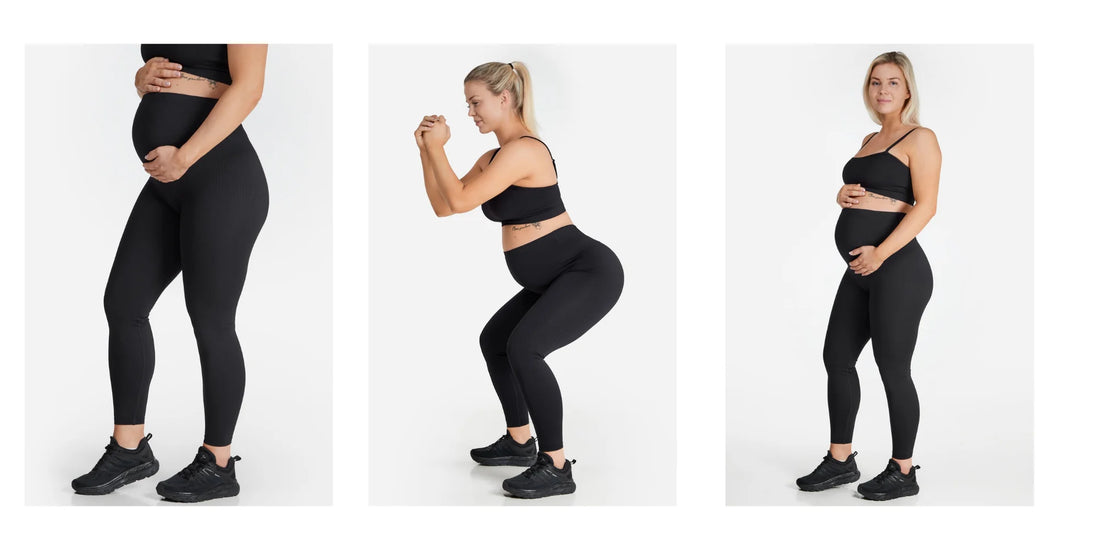
Training during pregnancy? We'll help you get started!
Many may think that exercising during pregnancy leads to an earlier birth and can have negative effects on labor, but according to Norwegian guidelines, as explained in the article from Jordmoderforeningen, maintaining or starting physical activity has no negative effects on labor and can halve the risk of premature birth.
Contents:
- Exercise in the first trimester
- Exercise in the second trimester
- Exercise in the third trimester
- Preventing urine leakage
- Preventing back pain
Physical activity is good for both you and the baby
When we talk about physical activity and exercise, we do not mean hard physical work with uniform, prolonged, and static movements. This often leads to negative consequences, even for those who are not in a vulnerable process like pregnancy. Physical activity and exercise should be varied and not prolonged, and the person performing these activities has control over the entire process and can take breaks whenever desired.
To get a little more motivation to get started, why not invest in some comfortable tights that fit well during pregnancy.
Also check out our collection of tights suitable for pregnancy!
If you are approaching your due date, you may want to take a look at our article about postnatal exercise.
How active you should be
During pregnancy, it is recommended to engage in physical activity for at least 30 minutes each day. The most important thing is to move regularly and raise your heart rate without sitting for too long at a time.
Those who have been active before pregnancy can continue as before with some precautions. Those who wish to exercise during pregnancy should gradually increase their activity level.
- If you have previously been very active and are used to heavy lifting, limit yourself to more moderate exercises and lighter weights.
- Avoid anything that may cause a significant increase in abdominal pressure.
- Avoid running and jumping during pregnancy, and try cycling, dancing or swimming. These exercises strengthen the pelvic floor and prevent urine leakage.
- Avoid activities where you might risk falling or getting hard impacts to the abdomen, as well as diving due to pressure changes that can negatively affect the fetus.
- Avoid exercising in extreme heat or high humidity and stick to moderate workouts.
If you are in a risk group for premature birth or have previously experienced multiple miscarriages, you should consult your doctor or midwife for more tailored advice.
Exercise in the first trimester
Focus areas: Strength, stamina, and rest
This covers the first 12 weeks of pregnancy, and the form varies from person to person. Some experience side effects such as nausea and fatigue during this period, so it may be wise to take this into account. You can exercise much like before pregnancy, but only if it gives you energy. It's important to get enough rest.
Start with pelvic floor training already in the first trimester. Some may experience low blood pressure, so make sure to drink enough water and rise slowly. Small and frequent meals can help reduce nausea.
Exercise in the second trimester
Focus areas: Stamina, strengthen back and gluteal muscles, stretching, resting, and pelvic floor
In the second trimester, it is essential to prioritize exercise that makes you happy, but preferably focus on the back, glutes, and pelvic floor. It can also be a good idea to train the arms, as you have a lot of carrying ahead. Avoid exercises that cause pain and discomfort, such as single-leg exercises, as they can exacerbate pelvic joint pain if you experience it.
Be cautious with exercises where the abdomen "bulges out like a triangle." This indicates that the exercises are too heavy, and you are improperly activating the muscles. Pay attention to possible urine leakage, and perform daily pelvic floor training.
Exercise in the third trimester
Focus areas: Daily movement, short and gentle strength training exercises, birth preparation exercises, and rest.
In this trimester, the essential function of exercise is to give you energy! Focus on movements that are good for body and mind, and protect the pelvic floor by avoiding high activation. Here, "a little is better than nothing" is an important mantra to get through the training days. Do not overexert yourself. Be kind to yourself and get enough rest. After all, you have the time to train ahead of you.
Versatile activity
As previously mentioned, you should try to be active for at least 30 minutes each day. Versatile activity with strength and stamina training is beneficial, and it's not necessary to sweat and be.
See our collection for pregnant women here


